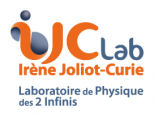
The photon spectrum of HESS J1731-347 fitted by using the lepto-hadronic model.
By P. Sharmaa, Z. Oub, C. Henry-Cadrota, C. Dubosa and T. Suomijärvia
aUniversité Paris-Saclay, CNRS/IN2P3, IJCLab, 91405 Orsay, France
bSchool of Physics and Astronomy, Sun Yat-sen University, 519082 Zhuhai, China
The origin of Galactic Cosmic Rays (CRs) and the possibility of Supernova Remnants (SNRs) being potential CR accelerators is still an open debate. The charged CRs can be detected indirectly by the gamma-ray observatories through the p0 production and consequent decay, leading to the generation of high-energy gamma rays. The goal of this study published in JCAP is to identify qualitative and quantitative trends in favor of hadronic scenarios and search for SNRs that could be potential accelerators up to PeV energies (PeVatrons).
We have performed a Multiwavelength (MWL) study using different radiative models to evaluate the hadronic contribution. The spectral energy distributions (SEDs) of selected SNRs are modeled using the Naima package. Two different radiative scenarios are considered, pure leptonic and lepto-hadronic scenarios, and different methods are used to evaluate their importance.
This study shows that the lepto-hadronic scenario is favored for most SNRs. Two particular indicators of hadronic contribution come from the data around the p0 production threshold and the data above a few TeV. The hard rise at the p0 production threshold cannot be explained by leptonic processes. More data in this region would be valuable for these studies. For some SNRs, an important hadronic contribution is observed up to a few TeV, thus making them promising PeVatron candidates. In this high-energy region where the leptonic processes are expected to be suppressed, more data is required to help distinguish between the leptonic and hadronic origin of gamma-ray emission. In the future, we intend to use the obtained model parameters to simulate data for CTA and assess its capability to identify PeVatrons.









